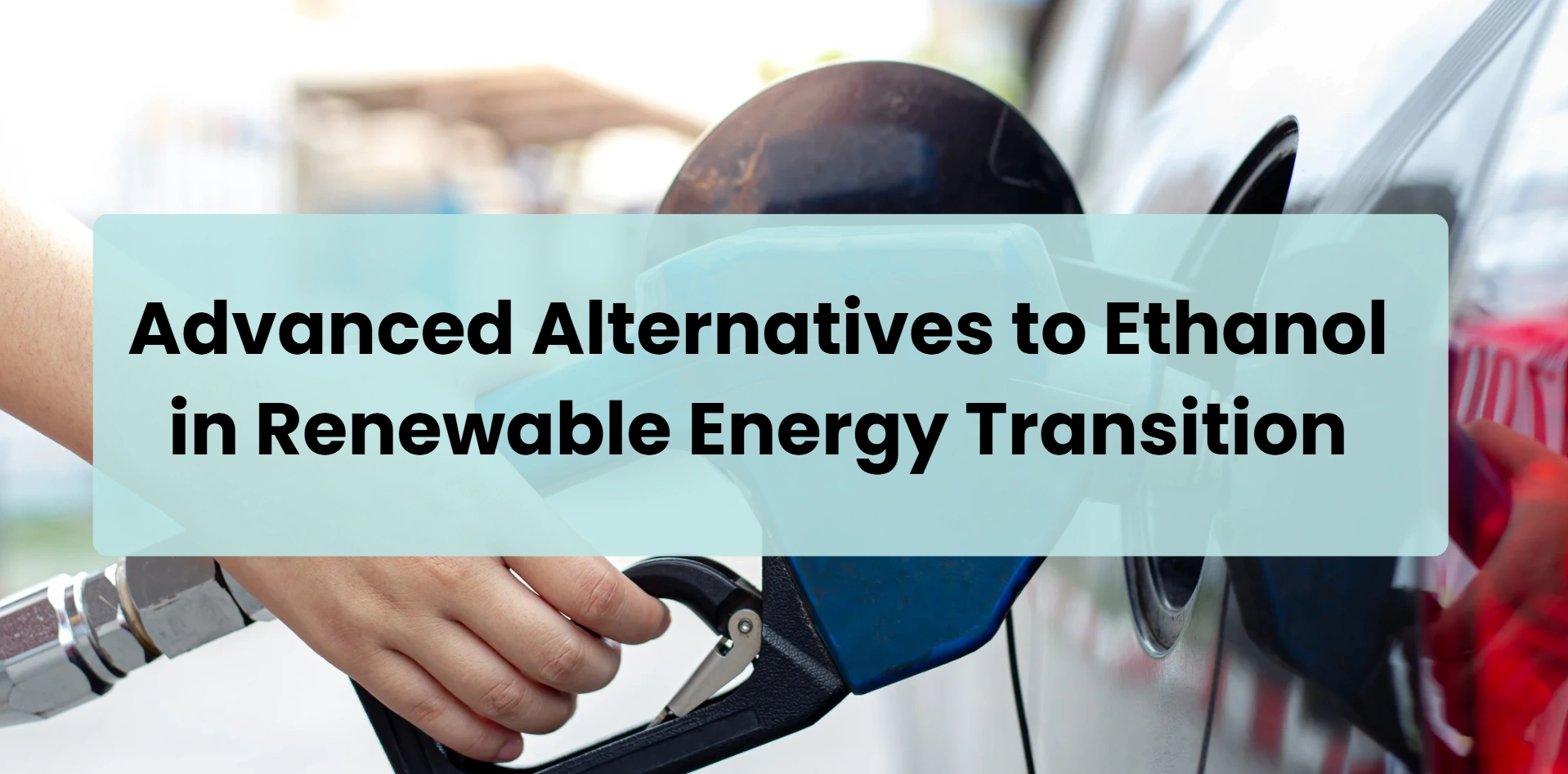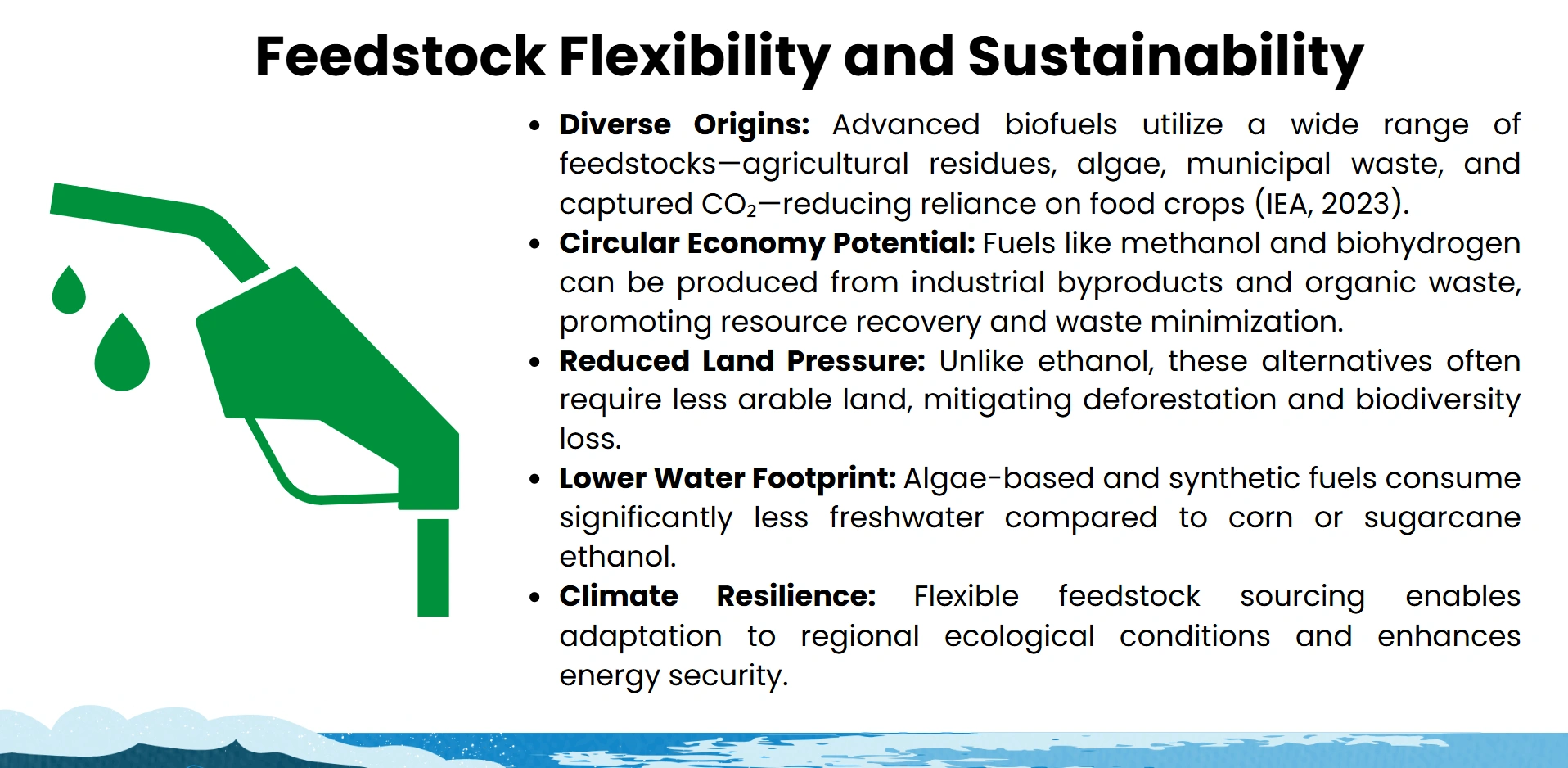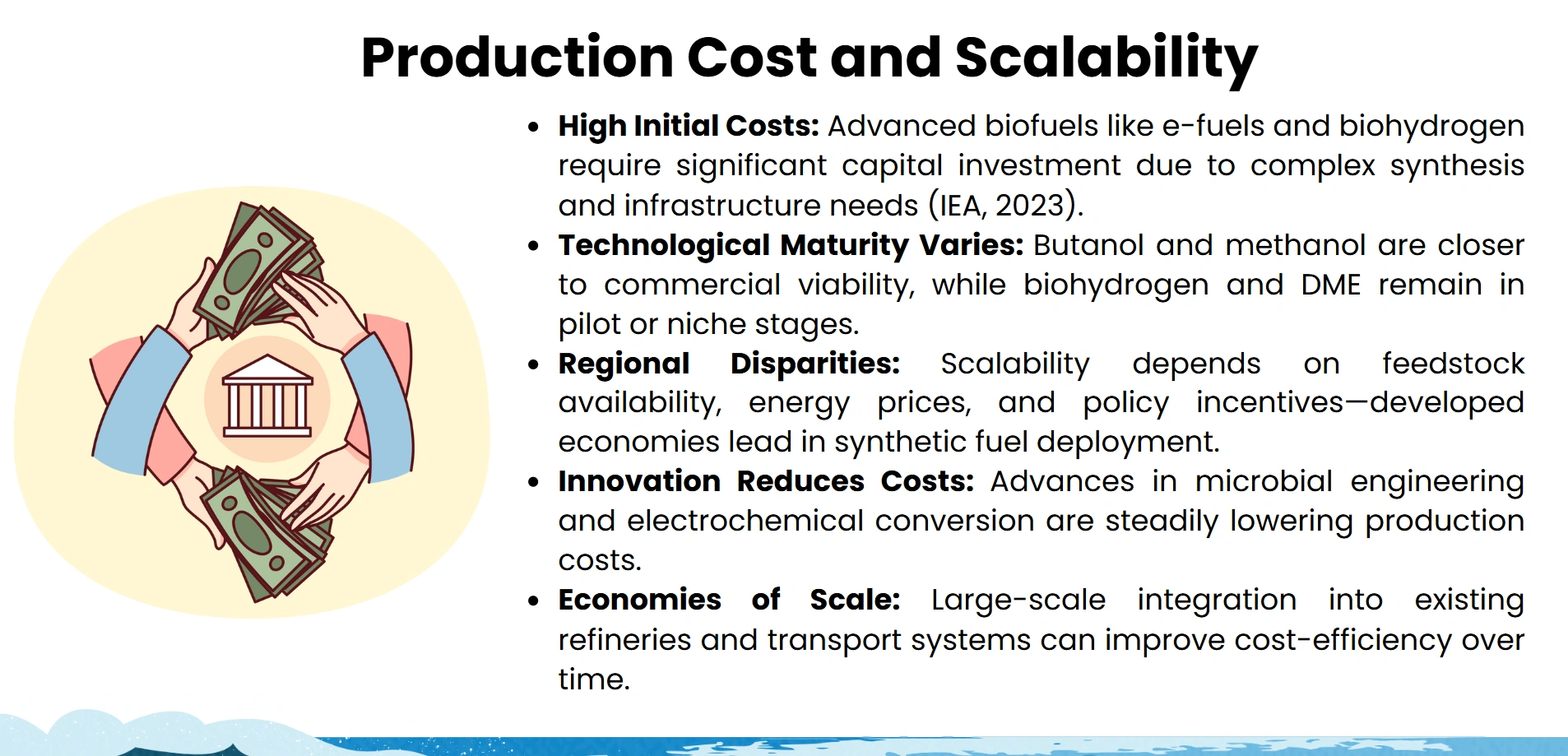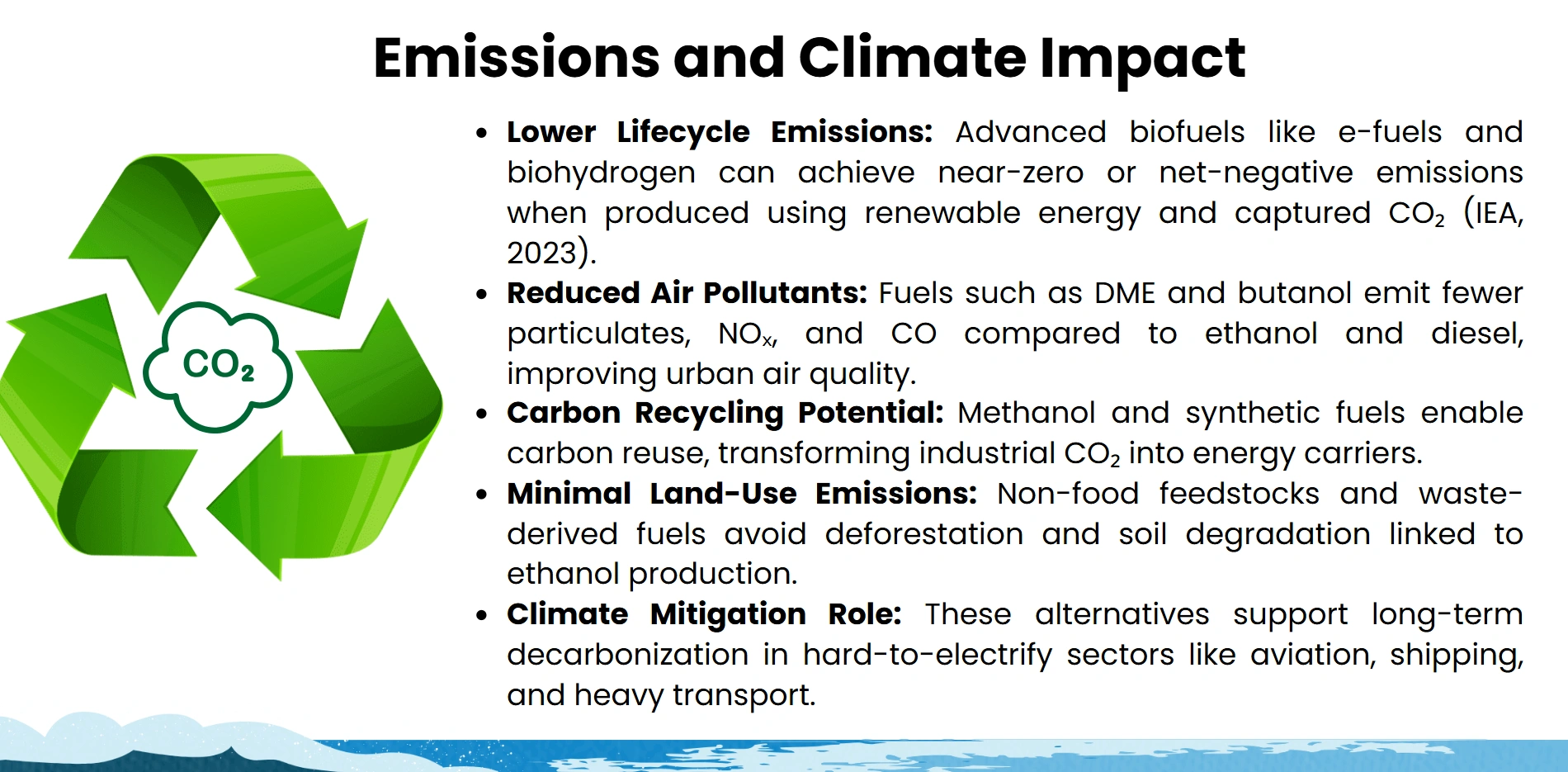The paper discusses more efficient biofuels besides ethanol-such as butanol, methanol, bio-hydrogen, and e-fuels, and their advantages, drawbacks, and prospects.

There has been increasing interest in biofuels as an alternative source of energy, as the world strives to promote the use of sustainable energy sources. Ethanol, which can be produced largely using sugarcane, corn, and other types of biomass, has long been touted as a key to biofuel plans due in large part because of its relative ease of production and due to its relative ease of integration into existing fuel infrastructure. The raised apprehensions regarding its penalties in the aspects of environment, i.e., land-use change, consumption of water and food versus fuel, have led to the recessive evaluation of its sustainability in the future. Simultaneously, fuel chemistry and biotechnology, as well as carbon capture, have spurred the adoption of alternative biofuels, with greater energy efficiency, lower emissions, and an expanded and more diverse set of feedstock candidates.This article discusses the environment of the promising ethanol substitutes, which are butanol, methanol, biohydrogen, dimethyl ether (DME), and synthetic e-fuels. All these fuels have their characteristic strengths and weaknesses in regard to their energy density, combustion characteristics, and compatibilities with the existing infrastructure, as well as technical, economic, and policy challenges. This examination of the alternatives using a multidisciplinary approach with elements of environmental science, engineering development, and governance mechanisms will hopefully help formulate better strategic choices when moving to a diversified and resilient renewable energy future. The discussion highlights the urgency of going beyond ethanol-focused approaches and adopting a larger set of sustainable fuel technologies.
What is the Rationale behind Considering Other Fuels Other than Ethanol?
Although ethanol has been a foundation in biofuel development, its drawbacks that are technical and ecologicaldrawbacks have led to an increased pursuit of advanced and sustainable types.
Restrictions in Energy Efficiency and Infrastructure Compatibility
Ethanol also has a relatively low energy concentration compared to gasoline and other complex biofuels, limiting its use in high-performance applications. It is hygroscopic (absorbs water), which makes transit and storage in established fuel infrastructure as a problem. Furthermore, the fuel mixtures that contain ethanol can result in corrosion of the pipelines and engines, which are not specially designed to use alcohol fuel, and this aspect leads directly to the necessity of costly retrofit or dedicated systems (Demirbas, 2009).
Environmental and agricultural trade-offs
Current commercial production of ethanol feedstocks, chiefly corn and sugarcane ethanol, has raised concerns of land-use change, loss of diversity, and the rise of greenhousegasesthrough the use of fertilizer and soil erosion. There is also still the food vs. fuel debate, as the use of certain agricultural products to make fuel may worsen the current food insecurity in the unstable areas. Such trade-offs question the sustainability ethanol narrative that is commonly attributed to ethanol.

Technological innovation and changes in policy
Global energy strategies are tilting toward fuels with greater carbon abatement potential and that are more feedstock flexible. Advancements in synthetic biology, carbon capture, and electro-fuels are also opening the way to next-generation biofuels that supersede ethanol in terms of lifecycle emissions, scaleability, and pairing with renewable energy systems. Other nations such as Germany and Japan are spending massively on e-fuels and hydrogen-based energy, which is an indication of a shift strategy that is not ethanol-focused (IEA, 2023).
Ethanol has a key position in the environmentally sustainable energy transition, yet this is not enough. A broad-based biofuel policy including alternatives such as butanol, methanol, and synthetic fuel,is necessary to develop long-term energy security and climate objectives.
Promising Alternative to Ethanol
With the world energy system shifting towards lower-carbon technologies and due to ethanol becoming a commodity, the market position of the commodity is being underpriced by a range of advanced fuels. These new fuels have better energy performance, increased feedstock flexibility, and lower environmental impact, which will make them high priorities in future renewable energy plans.
Butanol
Butanol is produced using natural products as a substrate through fermentation, has received attention because it has good physicochemical characteristics. However, butanol contains a larger energy densityof29.2 MJ/L as compared to ethanol, which is 21.1 MJ/L; this gives it a better ability to be used in combustion engines. It has lower volatility and less hygroscopicity; therefore, it is more safely stored and transported, and being compatible withexisting fuel infrastructure, it saves retrofit expenditure.
In addition, butanol can be combined with gasoline in higher proportions without requiring any engine alteration, which provides a smooth bridging experience between the consumers and the industries. Nonetheless, the commercialization of large-scale production is hampered by problems of low microbial biomassyield and recovery expenses. Improvement in metabolic engineering and synthetic biology is reducing these bottlenecks as genetically engineered strains of Clostridium and Escherichia coli seem to work towards this for fermentation efficiency improvement.

Methanol
A low-CO₂ solution is the use of methanol, a simple alcohol produced via biomass, natural gas, or captured CO2, and it is versatile and can be produced on a large scale. It can be produced using non-food biomass and industrial by-products, which fits into the aims of the circular economy, a decoupling to agricultural inputs. The high octane rating and clean-burning properties of methanol make it an apt fuel to use in high-power internal combustion engines and fuel cells.
China was the first to demonstrate the use of methanol blended fuels in transportation by blending with methanol. Nevertheless, methanol is toxic and corrosive, which is an obstacle to its mainstream usage especially at a consumer level. The hazards to health and safety necessitate rigorous handling and infrastructure upgrades. It has a strategic property as it can be used as a platform chemical to make dimethyl ether (DME) and making of olefins (Olah et al., 2009).
Biohydrogen
Biohydrogen is a zeroemission source of fuel that can have a transformative effect since it can be created using biological processes, namely, dark fermentation, photo-fermentation, and microbial electrolysis. The use of it as a fuel in hydrogen fuel cells is efficient and completely emissions-free, and so is well-suited to heavy-duty transport and stationary power applications.
The bottleneck of the scalability of biohydrogen is its low production yield and unacceptable costs of production. In addition, hydrogen has a relatively low energy density, and to achieve storage, it requires solutions such as high-pressure tanks or metal hydride, which have not yet become affordable and technically simple. In any case, policy activity development is picking up speed in the European Union and Japan with regard to funding hydrogen research and infrastructure, positioning biohydrogen as a cornerstone of future energy systems.
Dimethyl Ether (DME)
It is a derivative of methanol, it has properties which are similar to those of liquefied LPG, and is a clean-burning alternative. It can be produced by converting biomass, coal,ornatural gas, and most of the modifications to diesel engines are minimal. An ideal urban transport and industrial fuel should have a high cetane number and should not form soot during combustion, and thus DME.
It can be distributed at low cost due to its compatibility with existing LPG distribution infrastructure in those regions with an established distribution infrastructure. Nonetheless, accessibility and cost of feedstock are the main limiting factors. Incorporating DME production into bio-refineries and leveraging waste biomass has the potential to increase its viability. The potential in using the technology to serve public transport fleets has been proven through pilot projects in Sweden and Korea and therefore, the emerging technology is ready to be adapted in niche segments.
Synthetic Fuels (E-Fuels)
These are created by combining green hydrogen and captured carbon dioxide using Fischer-Tropsch processes. These fuels will be chemically similar to more traditional hydrocarbons, thus making a problem with the subsequent smooth integration of these fuels into existing vehicles, aircraft, and ships. They can have nearly zero lifecycle emissions powered by renewable electricity and made out of atmospheric or industrial CO2.
E-fuels can provide a long-term alternative. Nonetheless, their generation is technologically and financially intensive at present. The conversion of electricity to fuel entails losses that frequently surpass 50 percent; thus, there are concerns about economic efficiency. However, there is an increasing investment in pilot e-fuel plants in Germany and Chile, which can be scaled to decrease the prices (IEA, 2023).

Strategic Considerations and Comparative Advantages
All the alternative biofuels have their unique benefits and compromises. Biohydrogen and e-fuels are long-term transition options to decarbonize, while fuels like butanol and methanol can soon be compatible with the current infrastructure. DME is capable of crossing both of these frontiers due to its clean combustion characteristics as well as logistical viability. The selection of fuel will be influenced by the availability of the feedstocks regionally, technological maturity, and policy frameworks.
A comparative overview of these alternative fuels shows that butanol and DME score highly in compatibility with the existing engine system, methanol and biohydrogen are pretty high on the feedstock flexibility criteria, and e-fuels are very high on carbon neutrality. But none of them are without issues like toxicity, storage, cost, or scale. Planning of the deployment should consequently be situational, which combines technical practicability with ecological and financial issues.
The step towards the post-ethanol era is not a technological drive but rather a strategic need to have sustainable futures in energy. Advanced biofuels, including butanol, methanol, biohydrogen, DME, and synthetic e-fuels, hold a wide range of possibilities fordecarbonization and are uniquely applicable to specific industries and geographies. Further investment to strengthen research, infrastructure, and policy support is needed to unlock their potential. As countries seek energy systems that are resilient and low-carbon, a portfolio of advanced biofuels will be central to climate ambitions and energy security.
Policy, Innovation and Outlook
The future direction of biofuel alternatives is increasingly influenced by policy contexts that focus on decarbonization, energy alternatives, and Technologization.
- The world governments are revising their renewable strategies so as to promote other fuels other than ethanol as they acknowledge that the first version of biofuels has reached a wall in their renewable approach.
- Carbon emissions and feed-in tariffs and specific subsidies are being used to encourage the research and commercialization of such biofuels as butanol, biohydrogen, and synthetic e-fuels (IEA, 2023).
- Advances in fuel synthetic technology, microbe engineering, and carbon sequestering have sped the viability of these alternatives. As an example, recent advances in synthetic biology and the electrochemical conversion process are making e-fuels and biohydrogen production scalable with lower carbon footprints.
- The existence of public-private chains and international cooperation to at least partially realize cross-sector knowledge exchange and investment is being promoted through such mechanisms as the Mission Innovation Bio-future Platform.
- The ideal solution to biofuels is an assortment within a portfolio depending on the application of the sector; airlines, shipping, and heavy transport in this front.
- The incorporation of advanced biofuels in energy roadmaps in countries will necessitate aligning standards, lifecycle assessment protocols, and upgrading infrastructure.
Conclusion
Advanced biofuel alternatives to ethanol are part of a larger need to diversify and decarbonise global energy systems. Although ethanol has been used as a bridge fuel, it has proven to be inadequate in energy competence, environmental viability, and feasibility of scale. Fuels potentially coming into the market are butanol, methanol, biohydrogen, dimethyl ether, and synthetic e-fuels, which have other differentiated advantages related to technical, ecological, and infrastructure facets. Their ability to become a successful part of the national energy strategy will rely on the specific policy promotion, consistency in innovations, and case-specific implementation. These options create practical opportunities forlow-carbon mobility and industrial resiliency as commitments to climate change continue to gain momentum and fossil fuel reliance fades. Next-generation biofuels rely on a multidimensional approach that is scientifically rigorous, visionary in its policy and technological adaptability to optimize resources to support nascent biofuel technologies while ensuring good chances of success.